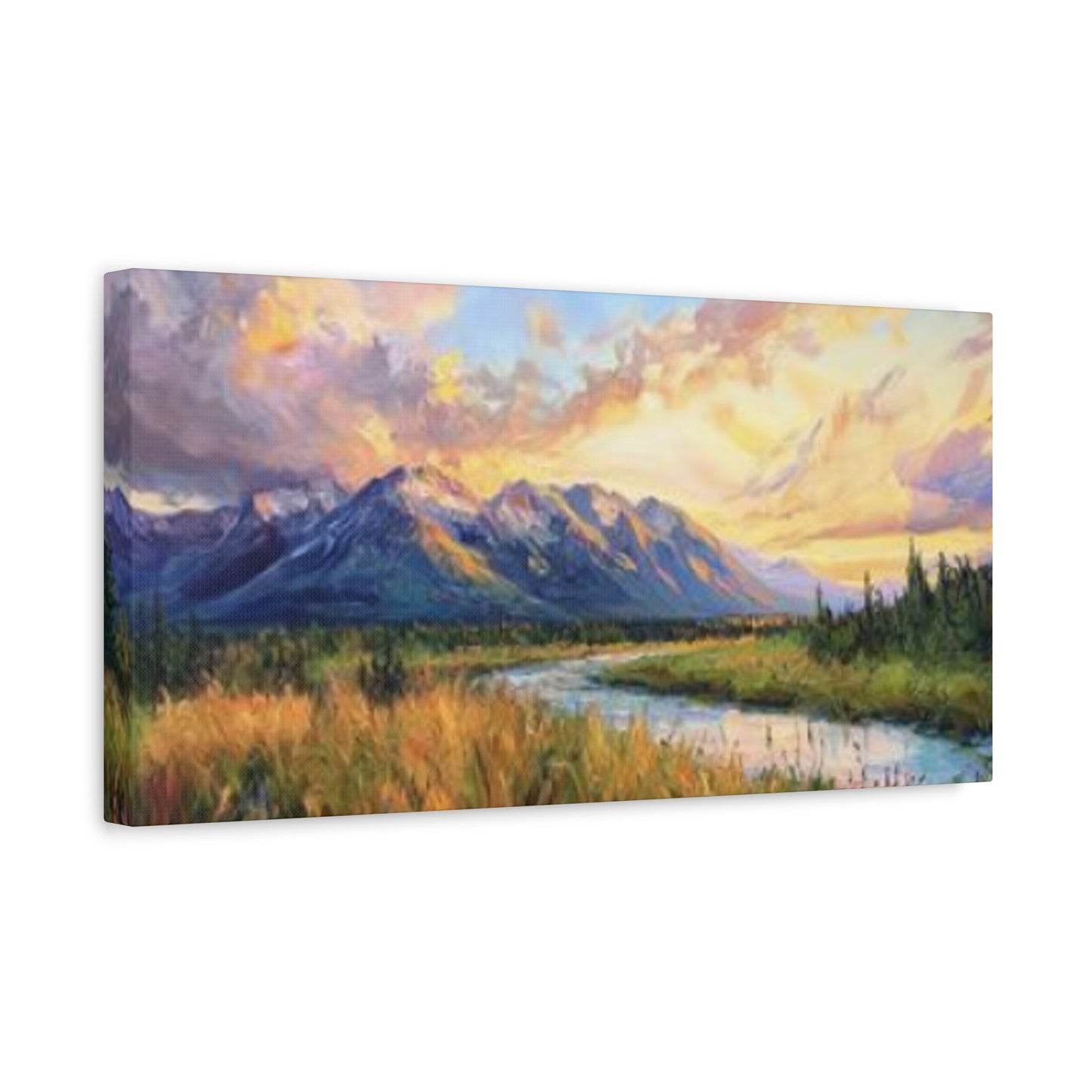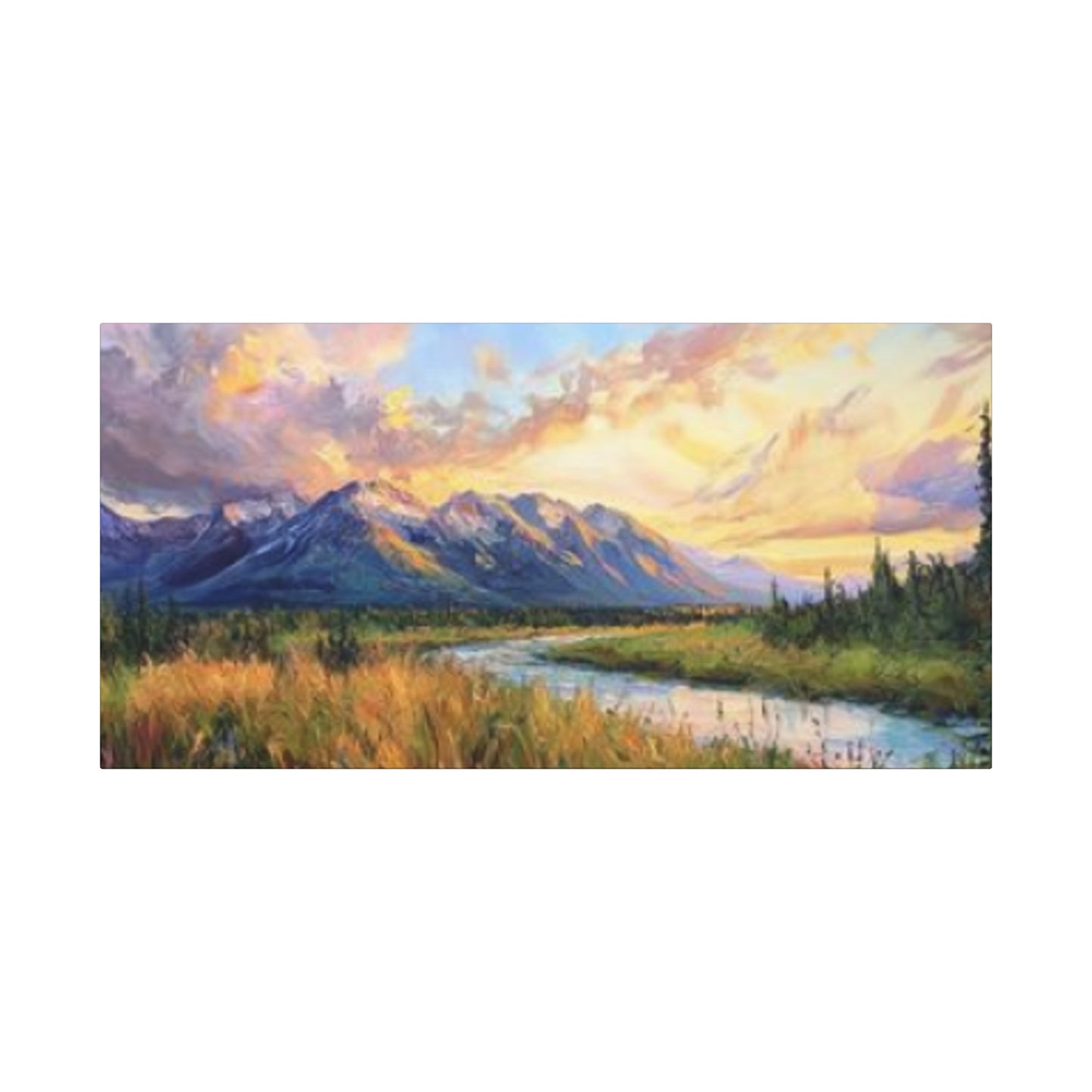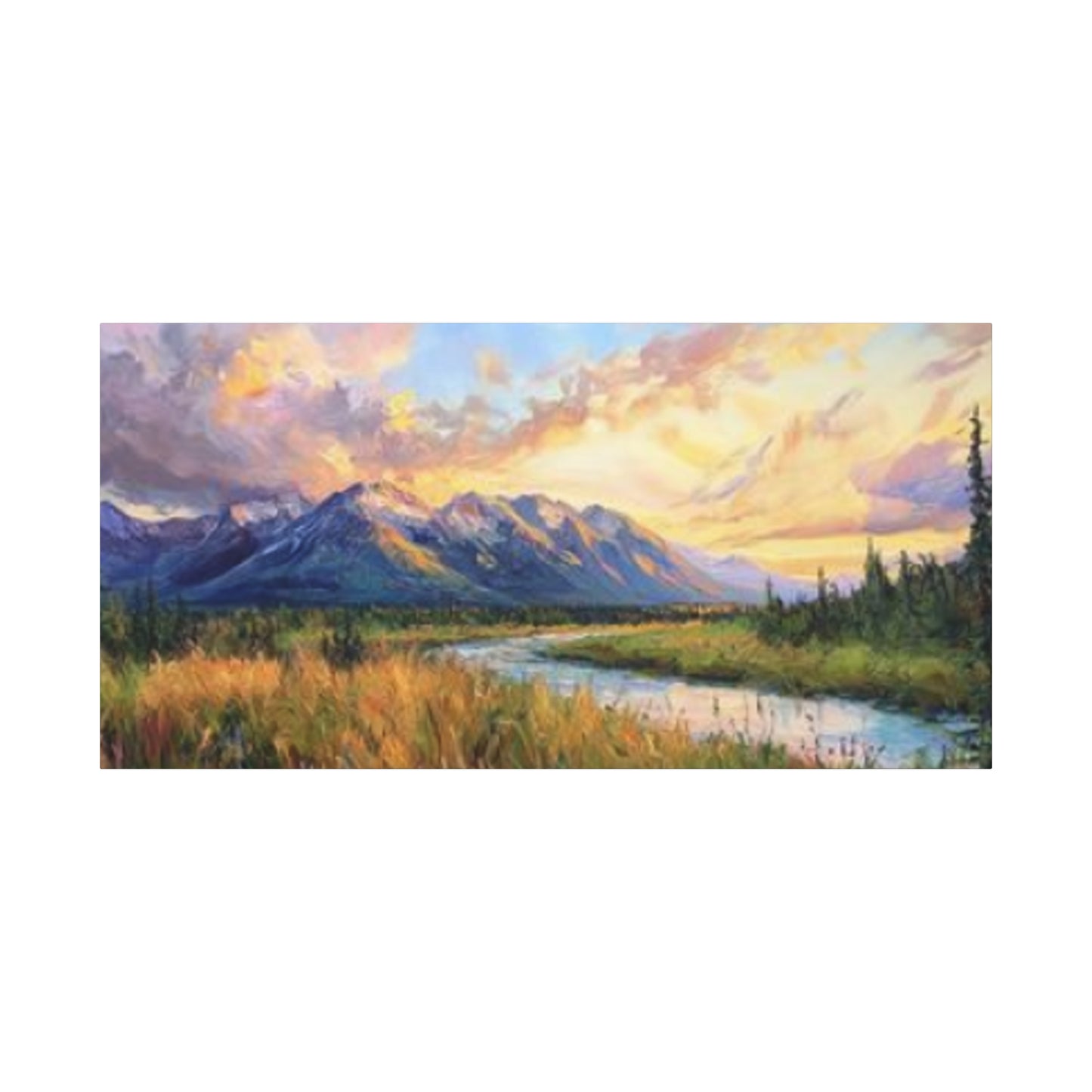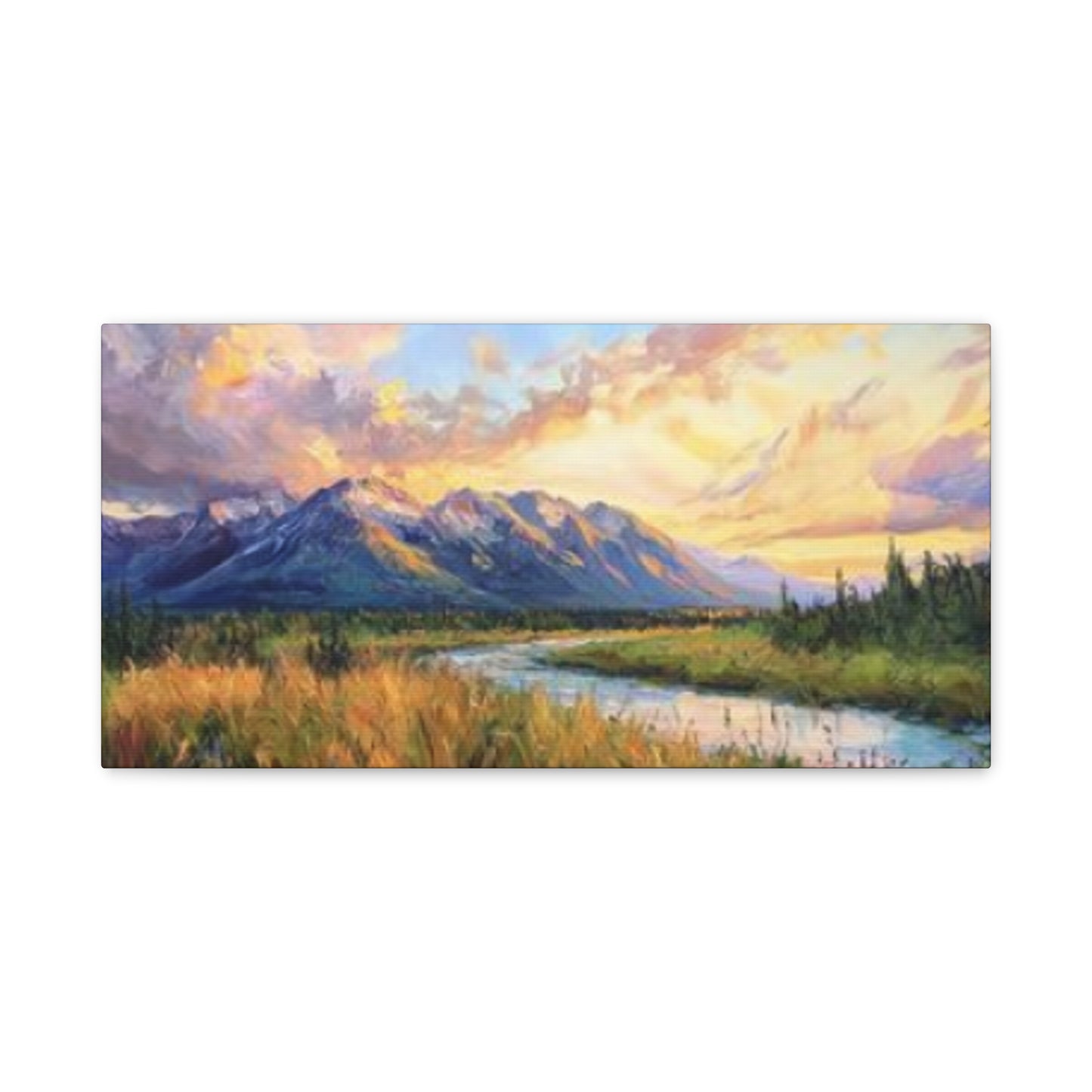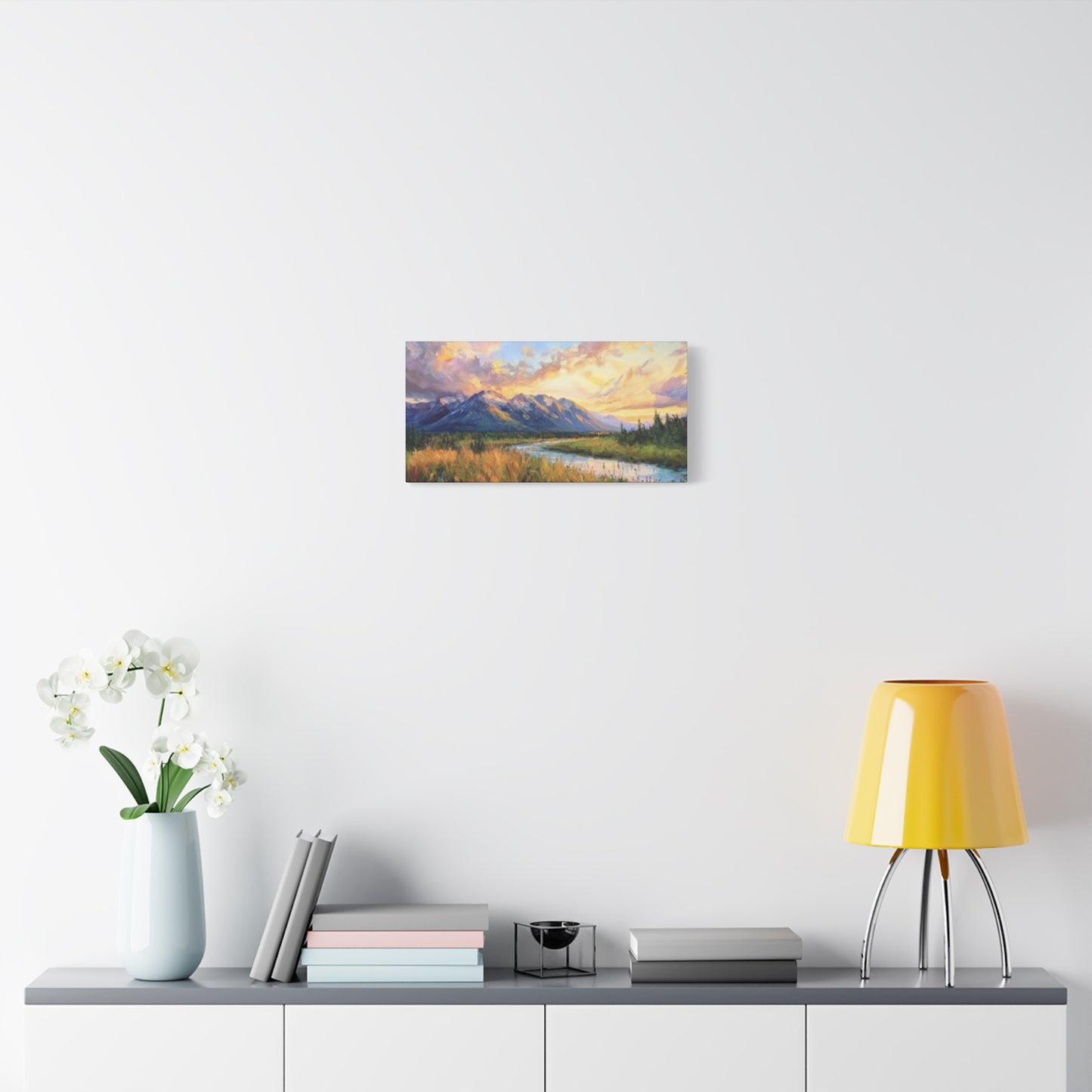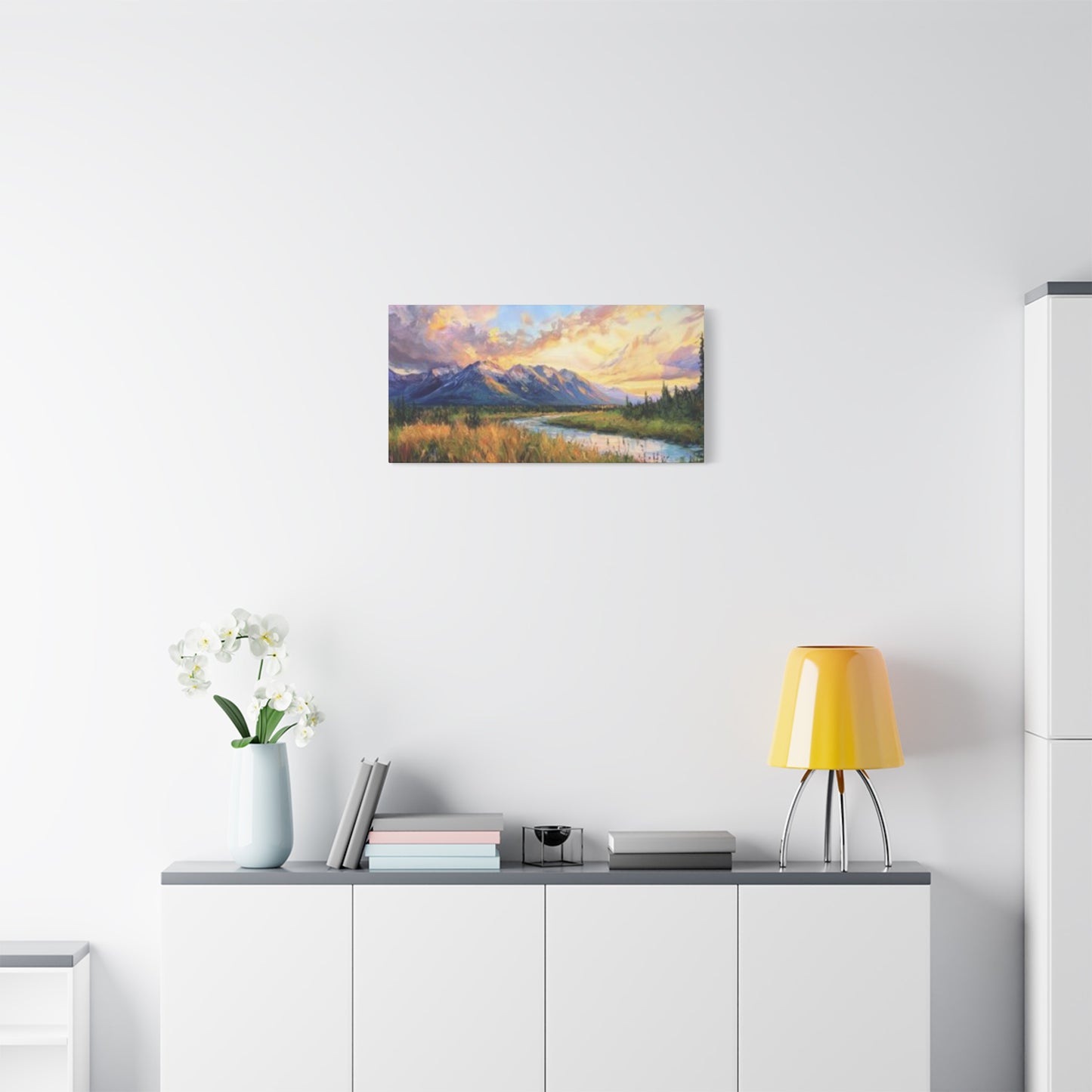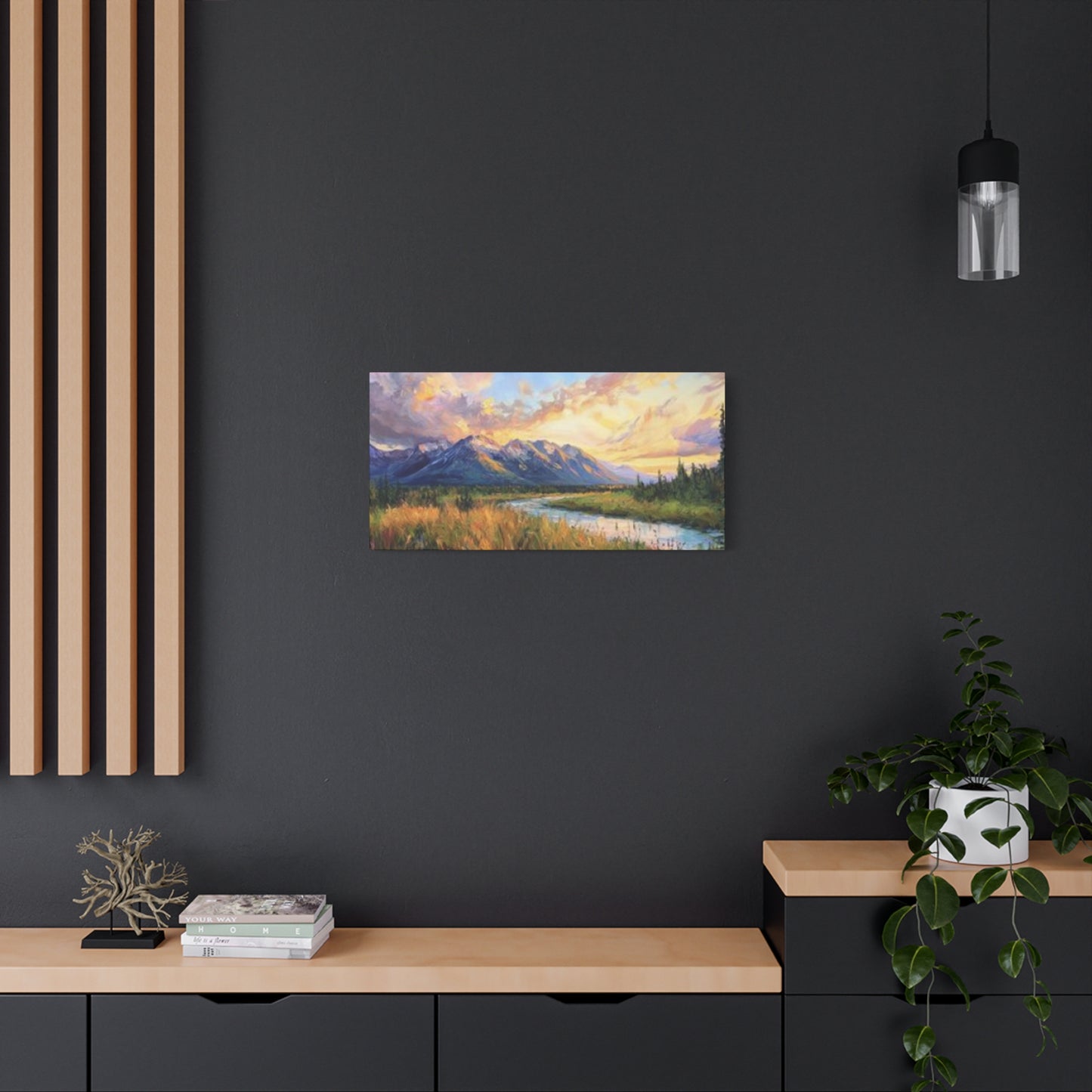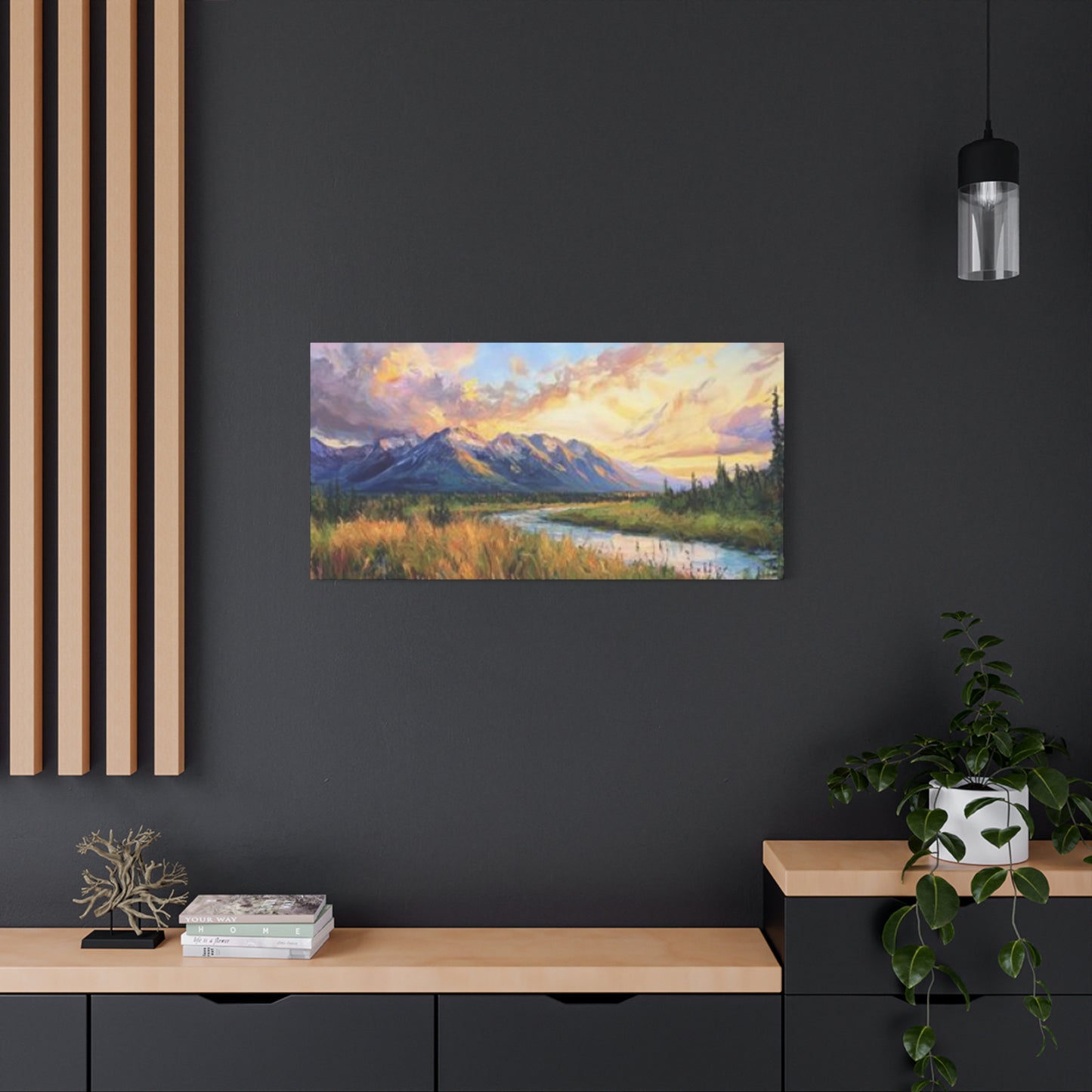Mountain and River Painting Panoramas Wall Art: Capturing the Majesty of Nature
The timeless beauty of natural landscapes has captivated artists and art enthusiasts for centuries, with mountain and river painting panoramas standing as some of the most sought-after forms of wall art canvas prints available today. These stunning visual representations bring the majesty of nature into interior spaces, creating focal points that transform ordinary rooms into extraordinary environments. Whether displayed in residential homes, commercial offices, or hospitality venues, panoramic landscape artwork featuring mountains and rivers offers a connection to the natural world that resonates deeply with viewers.
The appeal of these canvas prints extends beyond mere decoration. They serve as windows to serene environments, offering visual escapes that can reduce stress and enhance overall wellbeing. The horizontal format of panoramic pieces makes them particularly suitable for spaces above sofas, beds, or along hallway walls where they can command attention without overwhelming the room. Modern printing technologies have made it possible to reproduce these landscapes with remarkable clarity and color accuracy, ensuring that every detail from distant mountain peaks to flowing river currents appears vibrant and lifelike.
Collectors and interior designers alike appreciate how these artworks can anchor a room's aesthetic while providing flexibility in decorating schemes. The natural color palettes found in mountain and river scenes typically include blues, greens, earth tones, and whites, making them compatible with various interior design styles from rustic and traditional to contemporary and minimalist. This versatility has contributed to the enduring popularity of landscape panoramas in the wall art market.
Historical Significance of Landscape Painting in Art
Landscape painting has evolved dramatically throughout art history, with mountains and rivers serving as central subjects across multiple cultures and time periods. Ancient Chinese landscape paintings, known as shan shui, literally translated as mountain-water, established foundational principles that influenced Eastern artistic traditions for millennia. These works emphasized harmony between natural elements and often conveyed philosophical concepts related to balance and the relationship between humanity and nature.
During the European Renaissance, landscape elements began appearing more prominently in paintings, though they often served as backgrounds to religious or mythological scenes. The Dutch Golden Age of the seventeenth century marked a significant shift, with artists like Jacob van Ruisdael creating landscapes as primary subjects. These works celebrated the beauty of natural settings and demonstrated technical mastery in depicting atmospheric conditions, water reflections, and distant mountain ranges.
The Romantic movement of the late eighteenth and nineteenth centuries elevated landscape painting to new heights of emotional expression. Artists such as Caspar David Friedrich and J.M.W. Turner created dramatic mountain and river scenes that emphasized the sublime power of nature and its capacity to evoke profound emotional responses. Their works often featured solitary figures dwarfed by towering peaks or expansive waterways, suggesting themes of human insignificance before natural grandeur.
The Hudson River School in America during the mid-nineteenth century developed a distinctly North American approach to landscape painting. Artists like Thomas Cole and Albert Bierstadt captured the untamed wilderness of the American frontier, with particular attention to mountain ranges and river valleys. These paintings served both artistic and cultural purposes, documenting landscapes threatened by westward expansion while celebrating the natural beauty of the continent.
Impressionist painters revolutionized landscape art through their focus on light, color, and momentary atmospheric effects. Claude Monet's series paintings of haystacks, water lilies, and the Seine River demonstrated how the same landscape could be transformed by changing light conditions. This emphasis on visual perception rather than precise representation influenced subsequent generations of landscape artists and continues to inform contemporary approaches to depicting mountains and rivers.
The twentieth century brought diverse experimental approaches to landscape painting, from the bold colors of Fauvism to the geometric abstractions of Cubism. Despite these innovations, traditional representations of mountains and rivers maintained their appeal, with many artists continuing to explore realistic and semi-realistic interpretations. Today's canvas prints often draw inspiration from multiple historical periods, blending classical composition with modern color sensibilities and printing techniques.
Psychological Benefits of Nature-Inspired Wall Art
Research in environmental psychology has consistently demonstrated that exposure to nature imagery provides measurable psychological and physiological benefits. Mountain and river painting panoramas displayed as wall art canvas prints can contribute to these positive effects even when actual nature access is limited. Studies have shown that viewing natural landscapes can lower blood pressure, reduce cortisol levels, and promote feelings of calm and relaxation.
The concept of biophilic design, which incorporates natural elements into built environments, has gained significant traction in architecture and interior design. Nature-inspired artwork serves as an accessible means of implementing biophilic principles, particularly in urban settings where direct contact with natural environments may be restricted. Panoramic canvas prints featuring mountains and rivers can help satisfy the innate human need for connection with nature, a phenomenon known as biophilia.
Attention restoration theory suggests that natural environments help restore depleted cognitive resources by engaging involuntary attention rather than directed attention. When individuals view mountain and river landscapes, their minds can wander freely without the cognitive demands required in built environments filled with sharp edges, signs, and human-made structures. This mental rest can improve concentration, creativity, and problem-solving abilities.
Color psychology plays a significant role in the beneficial effects of landscape artwork. The blues and greens commonly found in mountain and river scenes are associated with tranquility, trust, and renewal. These colors have been shown to slow heart rate and create feelings of security and stability. Earth tones present in mountain paintings evoke groundedness and connection, while the whites of snow-capped peaks or rushing water suggest purity and clarity.
The horizontal format of panoramic landscapes particularly supports relaxation by mirroring the natural scanning patterns of human vision. Unlike vertical compositions that encourage upward movement and aspiration, horizontal panoramas promote lateral eye movement associated with calm observation and contemplation. This subtle difference in viewing experience can influence the overall atmosphere of a space and the emotional state of those who occupy it.
For individuals recovering from illness or managing chronic stress, mountain and river imagery can serve as focal points for meditation and mindfulness practices. The depth and complexity of landscape scenes provide visual interest that supports sustained attention without causing overstimulation. Healthcare facilities increasingly incorporate nature imagery into patient rooms and waiting areas, recognizing its role in promoting healing and reducing anxiety.
Artistic Styles and Techniques in Mountain River Landscapes
Photorealistic landscape paintings capture mountain and river scenes with meticulous attention to detail, creating images that rival photographs in their accuracy and clarity. Artists working in this style employ techniques that render every rock formation, tree branch, and water ripple with precision. When reproduced as canvas prints, these works provide viewers with highly detailed images that reward close examination while maintaining visual impact from a distance.
Impressionistic interpretations of mountain and river landscapes emphasize light, color, and atmospheric conditions over precise detail. This style captures the essence and emotional quality of a scene rather than its exact appearance. Brushstrokes remain visible, creating texture and movement that add energy to the composition. Canvas prints of impressionistic landscapes often feature vibrant color palettes and dynamic compositions that work particularly well in contemporary interior settings.
Abstract landscape paintings distill mountain and river forms into simplified shapes, colors, and textures. These interpretations may retain recognizable landscape elements while taking creative liberties with proportion, color, and spatial relationships. Abstract approaches allow artists to emphasize particular aspects of a landscape, such as the rhythmic patterns of mountain ridges or the flowing movement of water. Such prints appeal to collectors seeking artwork that suggests rather than depicts, leaving room for personal interpretation.
Traditional Chinese landscape painting techniques, including ink wash methods, create ethereal mountain and river scenes characterized by subtle gradations and minimalist compositions. These works often feature misty mountains emerging from fog, winding rivers, and carefully placed elements that guide the viewer's eye through the composition. Modern canvas prints reproducing these traditional styles bring ancient artistic wisdom into contemporary spaces, offering visual poetry that transcends cultural boundaries.
Watercolor landscapes possess a translucent quality particularly well-suited to depicting water, mist, and atmospheric effects common in mountain and river scenes. The medium's inherent fluidity creates soft edges and color blending that evoke the ever-changing nature of landscapes. Canvas prints of watercolor paintings retain the delicate qualities of the original medium while providing durability and longevity impossible with actual watercolor paper.
Mixed media approaches combine multiple artistic techniques and materials to create layered, textured landscape compositions. Artists might incorporate acrylic painting with ink drawing, digital elements with traditional painting, or collage elements with photographic imagery. These innovative combinations result in unique visual experiences that push the boundaries of traditional landscape representation. Canvas prints of mixed media works often feature rich surface textures that add dimensional interest to wall displays.
Palette knife painting creates heavily textured landscapes with thick applications of paint that catch light and create shadows across the canvas surface. This technique produces bold, expressive mountain and river scenes with dramatic visual impact. The raised paint creates an almost sculptural quality that adds physical dimension to the artwork. High-quality canvas prints can reproduce these textural effects, though viewing the original always provides a more tactile experience.
Selecting the Perfect Size for Your Space
Determining the appropriate size for mountain and river painting panoramas requires careful consideration of the wall space where the artwork will be displayed. Interior designers typically recommend that artwork occupy sixty to seventy-five percent of the available wall width above furniture pieces. For a sofa measuring eight feet in length, an ideal canvas print would range from five to six feet wide, creating visual balance without overwhelming the furniture or appearing diminutive.
Room dimensions significantly influence size selection. In larger rooms with high ceilings, oversized panoramic prints measuring six to ten feet wide can serve as dramatic focal points that anchor the space and provide appropriate scale. Conversely, smaller rooms benefit from moderately sized pieces that enhance the environment without making the space feel cramped. The viewing distance also matters; artwork intended to be viewed from across a room can be larger than pieces in spaces where viewers will be in close proximity.
Multiple-panel panoramas, also known as triptychs or multi-panel sets, offer flexibility in sizing and arrangement. These configurations allow larger overall dimensions while breaking the image into manageable sections that can be adjusted to fit specific wall configurations. The spacing between panels typically ranges from two to four inches, creating visual rhythm while maintaining compositional unity. This approach works exceptionally well for extra-wide wall spaces or areas with architectural interruptions like windows or doorways.
Vertical space considerations are equally important for panoramic formats. While these pieces emphasize horizontal dimensions, their height must be proportional to create pleasing visual balance. Standard panoramic ratios range from two-to-one to three-to-one, meaning a six-foot wide print might be two to three feet tall. Extremely wide ratios exceeding four-to-one can appear thin and may not provide sufficient visual weight for their horizontal span.
The relationship between ceiling height and artwork placement affects perceived proportions. In rooms with standard eight-foot ceilings, positioning artwork with its center at eye level, approximately fifty-seven to sixty inches from the floor, creates comfortable viewing angles. Higher ceilings allow for larger pieces hung at slightly elevated positions. The space between the top of furniture and the bottom of artwork should typically measure six to twelve inches, creating visual connection without direct contact.
Practical considerations including doorways, windows, and architectural features may constrain size options. Measuring all relevant dimensions before purchasing ensures the selected canvas print will fit the intended location while leaving appropriate breathing room. Creating paper templates at actual size and temporarily mounting them on the wall provides valuable perspective on how different dimensions will appear in the space. This simple step can prevent costly mistakes and ensure satisfaction with the final installation.
Custom sizing options offered by many canvas print suppliers provide solutions for challenging spaces or specific design visions. While standard sizes offer cost advantages, custom dimensions ensure perfect fit for unique wall configurations. When requesting custom sizes, maintaining appropriate aspect ratios prevents distortion of the original image. Communicating with print suppliers about intended display locations helps them recommend optimal dimensions based on their experience with similar projects.
Color Schemes and Interior Design Coordination
Successful integration of mountain and river painting panoramas into interior spaces requires thoughtful consideration of existing color schemes and design elements. Artworks featuring cool color palettes dominated by blues, greens, and grays complement contemporary and coastal design styles. These colors create calm, refreshing environments particularly suited to bedrooms, bathrooms, and spaces dedicated to relaxation. The natural association between blue tones and water, green tones and vegetation creates intuitive connections that feel organic within the space.
Warm-toned landscape prints incorporating oranges, reds, and golden yellows bring energy and coziness to interior environments. Sunset scenes over mountain ranges or autumn river valleys provide these warmer palettes while maintaining landscape subject matter. These pieces work beautifully in living rooms, dining areas, and spaces designed for social interaction. The warmth creates inviting atmospheres that encourage gathering and conversation.
Neutral landscape paintings featuring earth tones, grays, and subdued colors offer maximum versatility in coordination with existing decor. These pieces can anchor rooms with varied accent colors without competing for attention. The understated palette allows the subject matter and composition to take precedence while providing sophisticated visual interest. Neutral landscapes particularly suit minimalist, Scandinavian, and transitional design styles where restraint and balance are priorities.
Monochromatic or black and white mountain and river prints deliver dramatic impact through contrast and tonal variation rather than color. These pieces create striking focal points in modern and industrial-style interiors. The absence of color emphasizes form, texture, and composition, often producing more abstract impressions even from realistic subjects. Black and white landscapes pair exceptionally well with spaces featuring bold accent colors, as they provide visual grounding without adding additional hues to the palette.
Coordinating artwork with existing furniture and textile colors creates cohesive, designed environments. Identifying one or two colors present in the landscape painting and echoing them in throw pillows, rugs, or decorative accessories establishes visual connections throughout the space. This technique, known as color repetition, guides the eye around the room and creates a sense of intentionality in the design. However, exact color matching should be avoided in favor of complementary shades that relate without appearing overly coordinated.
Seasonal variation in landscape imagery can influence color coordination strategies. Spring and summer scenes typically feature brighter, more saturated colors including vibrant greens and clear blues. Autumn landscapes incorporate warm oranges, reds, and golden tones. Winter mountain scenes often emphasize whites, grays, and cool blues. Considering the seasonal quality of a landscape painting helps predict how it will feel in different times of the year and whether that aligns with the desired atmosphere for the space.
Lighting conditions significantly affect how colors in mountain and river paintings appear. Natural daylight reveals true colors most accurately, while warm incandescent lighting enhances reds and yellows but may dull blues and greens. Cool LED lighting can intensify blues and whites. Testing canvas prints under the actual lighting conditions where they will be displayed prevents surprises after installation. Many suppliers offer sample prints or return policies that facilitate this evaluation process.
The psychology of color combinations extends beyond individual hues to relationships between colors. Complementary color schemes, using colors opposite each other on the color wheel, create vibrant, energetic effects. Analogous schemes, featuring colors adjacent on the color wheel, produce harmonious, serene impressions. Mountain and river landscapes naturally incorporate multiple colors, so understanding which hues dominate the composition helps predict its overall color impact in the space.
Material Quality and Printing Technology
Canvas material quality directly impacts the appearance, longevity, and value of mountain and river painting panoramas. Premium canvas substrates typically use cotton or cotton-polyester blends with tight weaves that provide smooth, consistent surfaces for printing. Pure cotton canvas offers superior archival qualities and a traditional texture appreciated by fine art collectors. Polyester blends provide additional durability and resistance to stretching, making them practical choices for high-traffic areas or commercial installations.
The weight and thickness of canvas, measured in ounces per square yard, indicates its sturdiness and professional quality. Standard canvas weights range from eight to twelve ounces, with heavier weights offering greater durability and resistance to sagging over time. For large panoramic prints, heavier canvas weights ensure the artwork maintains proper tension on the stretcher frame and resists warping or waving, particularly in environments with temperature or humidity fluctuations.
Coating treatments applied to canvas before printing serve multiple functions including color optimization, UV protection, and moisture resistance. Specialized coatings create receptive surfaces for different ink types while preventing color bleeding or absorption that could dull the image. Water-resistant coatings provide protection against humidity and accidental splashes, extending the artwork's functional life. These treatments should be compatible with the printing technology to ensure optimal results.
Giclée printing represents the gold standard for reproducing artwork on canvas, utilizing archival pigment-based inks and high-resolution inkjet printers. The term giclée, derived from French meaning to spray, describes the printing process that produces museum-quality reproductions with exceptional color accuracy and detail. Giclée prints can achieve resolutions exceeding 1200 dots per inch, capturing subtle gradations and fine details essential for realistic mountain and river landscapes.
Pigment-based inks offer superior longevity compared to dye-based alternatives, with proper storage conditions enabling image stability for seventy-five to one hundred years or more. These archival inks resist fading from UV exposure and environmental pollutants, maintaining color vibrancy throughout their lifespan. For mountain and river panoramas intended as long-term investments or heirloom pieces, pigment-based printing is essential. The broader color gamut of professional printing systems ensures accurate reproduction of the subtle color variations found in natural landscapes.
UV-resistant protective coatings applied after printing provide additional safeguards against sun exposure and environmental damage. These clear coatings can also enhance color depth and add sheen options ranging from matte to glossy. Matte finishes minimize glare and reflections, making them ideal for spaces with significant natural light or across from windows. Satin finishes offer subtle sheen that enriches colors without excessive reflectivity. Glossy finishes maximize color vibrancy and contrast but may be problematic in bright lighting conditions.
Stretcher frames, also called stretcher bars, form the wooden framework over which canvas is wrapped and secured. Professional-grade frames use kiln-dried wood resistant to warping and feature beveled edges that prevent the frame from creating visible impressions on the canvas front. Gallery wrap construction, where the image continues around the frame edges, creates finished sides that eliminate the need for framing. This contemporary presentation style suits modern interiors and allows the artwork to float on the wall without visual interruption.
The depth or profile of stretcher frames influences the artwork's physical presence and shadow effects on the wall. Standard depths range from three-quarters of an inch to two inches, with deeper profiles creating more dramatic dimensional effects. Deeper frames work particularly well for large panoramic pieces, adding substantial physical presence that matches their visual impact. The frame depth should be proportional to the overall artwork size, with larger pieces typically benefiting from deeper profiles.
Corner construction methods affect frame stability and squareness over time. Premium stretcher frames use mortise and tenon joinery or precision-cut corner braces that maintain perfect ninety-degree angles. This precision ensures the canvas remains taut and square rather than developing waves or sags. Expandable or adjustable corner systems allow for future re-tightening should the canvas relax over time, though high-quality materials and proper initial stretching minimize this need.
Framing Options and Presentation Styles
Traditional picture framing provides mountain and river painting panoramas with defined borders and protection, though it adds cost and visual weight to the presentation. Wood frames in natural finishes complement landscape subjects by echoing organic materials. Options range from simple, narrow moldings that minimally interfere with the artwork to substantial frames that create formal, gallery-like presentations. Frame color and finish should harmonize with both the artwork and surrounding interior elements.
Metal frames offer sleek, contemporary alternatives to wood, with aluminum and steel options available in various finishes including brushed metals, powder-coated colors, and metallic sheens. These frames particularly suit modern and industrial interior styles. The clean lines and minimal profiles of metal framing allow the landscape artwork to dominate while providing crisp definition. Metal frames are also lightweight compared to wood, an important consideration for large panoramic pieces.
Floater frames create the illusion that canvas prints hover within the frame, with a visible gap between the canvas edge and frame interior. This presentation style showcases gallery-wrap edges while providing the structure and definition of framing. Floater frames work exceptionally well with panoramic landscapes, emphasizing their horizontal expanse while adding sophisticated finishing. The frame depth typically matches or slightly exceeds the canvas depth to achieve the floating effect.
Frameless presentation through gallery wrapping has become increasingly popular for contemporary canvas prints. In this approach, the image continues around all four canvas edges, and the piece mounts directly to the wall without framing. This clean, modern presentation maximizes the visual impact of panoramic formats by eliminating visual barriers between artwork and space. Gallery-wrapped pieces appear to emerge from the wall, creating dynamic, dimensional displays.
Shadow box framing creates substantial depth between the artwork and frame face, producing dramatic dimensional effects. This technique particularly enhances textured paintings or pieces where physical depth contributes to the artistic effect. The recessed positioning within the frame creates shadow play that changes with lighting angles throughout the day. Shadow boxes provide premium, museum-quality presentations suitable for significant investments in artwork.
Acrylic or plexiglass glazing protects framed canvas prints from dust, moisture, and physical contact while adding reflective or non-reflective surface qualities. Museum-grade acrylic offers UV filtering that protects against fading while remaining clearer and lighter than glass. However, many canvas purists prefer unglazed presentations that allow direct viewing of the canvas texture and eliminate reflective barriers between viewer and artwork. The decision depends on installation location, handling expectations, and personal preferences.
Matting, though less common with canvas prints than with paper artwork, can create visual breathing room between the image and frame. A mat in neutral colors provides transition space that allows the eye to rest before engaging with the landscape image. This classical presentation style suits traditional interiors and formal settings. Mat width should be proportional to artwork size, with larger pieces accommodating wider mats without appearing diminished.
DIY framing options enable budget-conscious collectors to customize presentations while controlling costs. Pre-made frame kits in standard sizes offer accessible solutions for canvas prints matching common dimensions. These systems typically include corner pieces and hanging hardware, with instructions for assembly. While requiring some manual skill, DIY framing can produce professional results at significantly lower cost than custom framing services.
Professional framing services provide expertise in selecting appropriate framing materials and techniques for specific artworks and installations. Frame shop consultants can advise on proportions, colors, and styles that enhance particular mountain and river landscapes while coordinating with interior environments. The investment in professional framing often proves worthwhile for significant pieces or installations in prominent locations where presentation quality impacts overall interior design success.
Placement Strategies for Maximum Impact
Living room placement of mountain and river painting panoramas typically centers above seating furniture, with the artwork serving as the room's focal point. The horizontal expanse of panoramic formats naturally suits walls behind sofas or entertainment centers. Positioning should account for sightlines from various seating areas, ensuring the artwork remains visible and engaging from multiple viewpoints. The relationship between furniture scale and artwork dimensions requires careful balancing to achieve visual harmony.
Bedroom installations benefit from serene mountain and river imagery that promotes relaxation and restful sleep. Above-bed placement is most common, with the artwork centered on the wall and positioned to be viewed from the bed and entry. The calming subject matter and typically cool color palettes of water landscapes create ideal atmospheres for sleep spaces. Ensuring adequate space between the top of the headboard and bottom of the artwork prevents crowding while maintaining visual connection.
Dining room walls provide excellent opportunities for panoramic landscape displays that enhance the dining experience without competing with table settings or social interaction. These spaces often feature continuous wall expanses ideal for wide-format artwork. Mountain and river scenes can be conversation starters while maintaining appropriate emotional tones for shared meals. Positioning should consider lighting from chandeliers or pendant fixtures to avoid glare while ensuring adequate illumination.
Home office environments benefit from nature imagery that supports focus and creativity. Mountain and river panoramas positioned within the visual field, but not directly behind computer monitors, provide opportunities for visual breaks that restore attention. The psychological benefits of nature imagery can reduce stress and mental fatigue associated with extended work periods. Placement should facilitate easy viewing during short breaks while not creating distracting elements during concentrated work.
Hallways and corridors offer ideal locations for panoramic formats that emphasize horizontal movement through space. The extended width of mountain and river landscapes naturally complements linear hallway architecture. Multiple smaller panoramas can be arranged in series to guide movement and create rhythm along extended walls. Lighting becomes particularly important in hallways, which often lack natural light sources and require supplemental illumination to showcase artwork effectively.
Entryways and foyer spaces benefit from impressive landscape artwork that creates strong first impressions. Mountain and river panoramas communicate taste, sophistication, and connection to nature immediately upon entry. The scale should match the vertical space available while avoiding overwhelming smaller entry areas. Consideration of viewing distance is critical, as foyer art is often viewed briefly and from limited positions.
Stairway walls present unique opportunities and challenges for artwork placement. The ascending or descending sightlines require careful positioning to ensure comfortable viewing angles. Panoramic landscapes can follow stair angles or create counterpoint through horizontal orientation. Gallery arrangements of multiple related pieces can create dynamic displays that engage viewers throughout their ascent or descent. Professional installation is often advisable for stairway placements due to access challenges and the importance of precise positioning.
Commercial spaces including offices, hotels, restaurants, and healthcare facilities utilize mountain and river panoramas to create welcoming, stress-reducing environments. Reception areas benefit from impressive landscape installations that occupy guests and create positive first impressions. Conference rooms can incorporate nature imagery that promotes calm, focused discussions. Patient rooms and waiting areas in healthcare settings use landscapes to reduce anxiety and support healing processes. Scale considerations in commercial installations often differ from residential applications, with larger spaces accommodating and often requiring more substantial artwork.
Seasonal Variations in Mountain River Imagery
Spring mountain and river landscapes capture the awakening of nature through fresh greens, blooming vegetation, and rushing waters swollen with snowmelt. These scenes convey renewal, growth, and optimism through their imagery and color palettes. Trees display new leaf growth in luminous greens ranging from yellow-green to deeper forest tones. Rivers run high and energetic, often depicted with white water rapids and vigorous currents. Sky colors tend toward clear blues with white clouds, and lighting quality captures the crisp clarity characteristic of spring.
Summer scenes present mountain and river landscapes at peak verdancy, with fully developed foliage in rich, saturated greens. Water levels stabilize, allowing for clearer, calmer river depictions with visible reflections and aquatic life. Wildflowers often dot meadows and riverbanks in vibrant colors. Lighting in summer mountain scenes tends to be warm and golden, particularly during the extended daylight hours of long summer days. These images evoke vacation, leisure, and the abundance of the natural world at its most productive.
Autumn transforms mountain and river landscapes into spectacular displays of warm colors as deciduous trees change from green to yellow, orange, red, and brown. This seasonal variation provides some of the most visually dramatic landscape imagery available. Rivers reflect the colorful foliage along their banks, doubling the visual impact of autumn hues. Cooler air creates mist and fog effects that add atmospheric depth to mountain scenes. The quality of light becomes softer and more directional as the sun's angle lowers, creating longer shadows and warm illumination particularly in early morning and late afternoon.
Winter mountain and river scenes emphasize whites, blues, and neutral tones as snow blankets peaks and valleys. Rivers may partially freeze, creating patterns of ice and flowing water. Snow-covered evergreen trees provide texture and dark contrast against white landscapes. The quality of light in winter scenes tends to be cool and crisp, with sharp shadows and brilliant highlights on snow surfaces. These images convey purity, quietude, and the stark beauty of landscapes in dormancy.
Seasonal transitions, or shoulder seasons, offer unique landscape qualities combining elements of adjacent periods. Late winter-early spring captures snowmelt processes and the first emergence of green growth. Late summer-early fall shows the beginning of color change while maintaining summer's warmth. These transitional scenes avoid the visual dominance of peak seasonal characteristics, offering subtle beauty that rewards careful observation.
Geographic location significantly influences seasonal appearance in mountain and river landscapes. High-altitude regions maintain cooler conditions and shorter growing seasons, with snow potentially present even in summer months. Tropical mountain regions may show minimal seasonal variation in vegetation while experiencing wet and dry seasons affecting water levels. Understanding the geographic context of landscape imagery helps predict its seasonal associations and emotional resonances.
Multi-season collections allow rotation of mountain and river panoramas throughout the year, refreshing interior spaces and maintaining alignment with outdoor seasonal changes. This approach requires investment in multiple pieces but provides ongoing variety and seasonal appropriateness. Storage of off-season artworks should protect them from temperature extremes, moisture, and physical damage. Some collectors maintain seasonal galleries, displaying all pieces in rotation within dedicated spaces.
Seasonally neutral landscapes avoid strong seasonal markers, depicting scenes that could plausibly exist in multiple seasons. These images often feature evergreen forests, rocky mountain peaks above the tree line, or rivers in relatively constant flow. The color palettes tend toward blues, grays, and earth tones rather than the vivid greens of summer or warm tones of autumn. Seasonally neutral pieces offer flexibility for year-round display without requiring rotation.
Regional Landscape Characteristics
Alpine mountain and river landscapes feature dramatic vertical relief with snow-capped peaks, glaciers, and steep valleys carved by ancient ice flows. Rivers in these regions often begin as glacial melt, carrying suspended sediment that creates distinctive turquoise or gray-blue coloration. Vegetation follows elevation-based zones, from forested lower slopes through alpine meadows to barren rock and permanent snow. The stark beauty and extreme environments of alpine regions create powerful, awe-inspiring imagery suitable for bold interior statements.
Rocky Mountain landscapes of North America showcase rugged, jagged peaks formed by tectonic uplift and erosion. Rivers cut through mountain valleys, ranging from rushing mountain streams to major waterways like the Colorado River. Forests of pine, spruce, and aspen cover lower elevations, while above the tree line, tundra vegetation dominates. Seasonal variation is pronounced, with spectacular autumn aspen displays and heavy winter snowfall. These landscapes embody the spirit of the American West and resonate with cultural associations of wilderness and frontier exploration.
Appalachian mountain and river scenes present older, more weathered mountains with rounded peaks and extensive forest coverage. Rivers in this region tend toward wider, more meandering courses compared to the steep gradient streams of younger mountain ranges. The biodiversity of Appalachian forests creates rich visual textures with multiple tree species, dense understory vegetation, and seasonal variation. Morning mist and fog frequently blanket valleys, creating atmospheric conditions favored by landscape painters and photographers.
Sierra Nevada imagery captures the distinctive granite formations, dramatic waterfalls, and alpine lakes characteristic of California and Nevada ranges. Rivers here include iconic waterways like the Merced River flowing through Yosemite Valley. The combination of massive rock faces, waterfalls, and mixed conifer forests creates compositions of exceptional visual drama. The quality of light, influenced by the region's Mediterranean climate, tends toward clarity and brilliance particularly valued in landscape photography and painting.
Cascade Range landscapes feature volcanic peaks, extensive forests, and rivers fed by substantial precipitation. The green valleys and multiple waterfalls create lush scenes quite different from drier mountain regions. The presence of active and dormant volcanoes adds geological interest and distinctive peak profiles to landscape compositions. Rivers in the Cascades range from powerful waterways like the Columbia River to countless smaller streams and waterfalls tumbling down mountainsides.
European Alps present centuries of human interaction with mountain landscapes, with villages, farms, and infrastructure integrated into natural settings. Rivers here have been significant trade and travel routes throughout history. The combination of dramatic natural features and human cultural elements creates landscape opportunities unavailable in purely wilderness settings. Classic Alpine imagery balances natural grandeur with evidence of long-term habitation and mountain agriculture.
Asian mountain and river landscapes vary tremendously across the vast continent but include the Himalayas, which dominate landscape imagery with the world's highest peaks. Rivers originating in these mountains, including the Ganges, Yangtze, and Mekong, support billions of people downstream. Traditional artistic representations emphasize spiritual dimensions and philosophical relationships between humanity and nature. Mist-shrouded peaks emerging from clouds create quintessentially Eastern landscape aesthetics that have influenced global artistic traditions.
Scandinavian mountain and river landscapes present unique qualities related to high latitude locations and glacial geology. Fjords, narrow sea inlets carved by glaciers and flanked by steep mountains, create distinctive compositional opportunities. Rivers tend to be shorter and steeper than in continental regions. The quality of light varies dramatically with season, from the endless daylight of summer to the brief, low-angle illumination of winter. These characteristics create landscape imagery with distinctive color palettes and atmospheric conditions.
South American Andes landscapes feature the world's longest continental mountain range, with extreme elevation changes and diverse ecosystems. Rivers beginning in high peaks descend to tropical rainforests, creating dramatic transitions in vegetation and landscape character. The cultural heritage of Andean civilizations adds historical dimensions to landscape imagery. Glacial lakes in brilliant turquoise colors create stunning focal points in mountain compositions.
Photography Versus Painted Mountain River Art
Photographic mountain and river landscapes offer documented reality, capturing specific locations and moments with technical precision. Modern camera technology enables detail resolution and dynamic range that reveals textures and subtleties imperceptible to the unaided eye. Photographers can capture challenging lighting conditions including sunrise, sunset, and stormy weather that add drama and emotional impact. The documentary quality of photography appeals to viewers interested in actual places they might visit or have personal connections to.
Painted mountain and river artworks provide interpretive, emotional responses to landscapes rather than literal documentation. Artists can emphasize particular elements, simplify compositions, or enhance colors beyond natural appearance to achieve desired aesthetic effects. Painting techniques introduce texture and visible brushwork that add physical dimension and artistic signature to the work. The hand-crafted nature of painting carries cultural associations with artistry, skill, and unique creation that photography, despite its technical demands, may not automatically convey.
The emotional qualities of photography versus painting differ substantially despite similar subject matter. Photography's documentary realism can create strong sense of place and authenticity, allowing viewers to imagine themselves within the depicted landscape. Painting's interpretive nature invites imaginative engagement, with the artist's creative choices visible in color selections, composition, and technique. Neither approach is inherently superior; rather, they offer different viewer experiences and fulfill different aesthetic purposes.
Technical considerations affect the reproduction quality of each medium as canvas prints. Photographic images require sufficient resolution to print at desired sizes without visible pixelation or loss of detail. Professional landscape photography typically uses high-resolution cameras producing files of fifty megapixels or more. Painted artwork can be photographed or scanned for reproduction, though capturing accurate color and texture requires specialized equipment and expertise. Digital paintings created directly in software offer technical advantages for reproduction while allowing artistic flexibility.
Artistic movements and styles are more strongly associated with painted works than photography, though photographic styles certainly exist. Impressionistic, realistic, abstract, and expressionistic approaches are well-defined in painting with centuries of development and critical theory. Photography has developed its own stylistic categories but operates within the constraints of representing actual subjects. This distinction affects collector preferences, with some preferring photography's realism and others favoring painting's artistic interpretation.
The market for mountain and river canvas prints includes both photographic and painted imagery, with buyer preferences varying by demographics, interior design contexts, and personal taste. Contemporary and modern interiors often favor photographic prints for their clean, realistic aesthetic. Traditional and transitional spaces may lean toward painted works that connect with historical artistic traditions. Commercial installations often select based on intended emotional tone and brand alignment rather than medium preferences.
Hybrid approaches combining photography and painting techniques offer expanded creative possibilities. Digital manipulation allows photographers to enhance colors, add painterly effects, or combine multiple exposures in ways that move beyond pure documentation while maintaining photographic foundations. Traditional painters may work from photographic references or incorporate photographic elements into mixed media pieces. These hybrid approaches blur medium boundaries and create unique artistic visions.
Conclusion
In the ever-changing rhythm of modern life, where screens and concrete often dominate our view, Mountain and River Painting Panoramas Wall Art brings us back to what is timeless — the majesty of nature. These breathtaking works of art do more than fill empty spaces; they awaken something deep within us, a longing for balance, peace, and connection to the natural world. Every mountain peak painted in soft hues and every flowing river rendered with fluid brushstrokes serves as a visual reminder that serenity still exists — we only have to let it in.
Decorating your home with panoramic nature art isn’t just a design choice; it’s a reflection of values. It shows an appreciation for the quiet strength of mountains and the graceful persistence of rivers. Together, they represent the harmony between endurance and flow — a perfect metaphor for life itself. When hung in your living room, bedroom, or hallway, these panoramas don’t just elevate the aesthetic appeal of your home; they create a sanctuary where tranquility and grandeur coexist.
The interplay of mountains and rivers in a panoramic canvas evokes both stability and motion. Mountains, standing tall and majestic, symbolize resilience and permanence — the grounding forces that keep us centered. Rivers, in contrast, represent life’s constant evolution — always moving, adapting, and shaping their path. When combined, they form a scene that feels complete, reminding us that both stillness and movement are essential in creating harmony, both in nature and within ourselves.
A panoramic mountain-and-river artwork captures perspective like no other. Its wide format allows your eyes to travel naturally, following the curves of valleys or the glisten of water as it winds toward the horizon. This sense of depth gives your walls a breathtaking openness, making even smaller spaces feel expansive. It’s as though you’ve invited the outdoors in — allowing nature’s calm to become part of your daily rhythm.
Color plays an essential role in the emotional depth of these panoramas. Cool blues, misty greys, and earthy greens create a peaceful palette that soothes the senses, while touches of sunrise gold or twilight purple add drama and warmth. Whether your preference is for hyper-realistic landscapes or abstract impressions, the result is always the same — a composition that rejuvenates the mind and restores emotional clarity.
Lighting can enhance the experience even further. Soft ambient lighting or focused spotlights can bring a painted river to life, making the water shimmer as though it’s truly flowing. In a dimly lit room, the shadowed slopes of mountains seem to breathe, their contours deepening with every glance. The effect is immersive, as if the artwork is alive — a moving meditation that evolves with the light of day.
Beyond its aesthetic appeal, mountain and river wall art carries emotional and even spiritual meaning. The mountains inspire courage and perseverance, while the rivers teach surrender and trust. Together, they encourage mindfulness — reminding us to stand strong yet remain flexible. This makes such artwork perfect not only for living rooms and hallways but also for meditation spaces, offices, or bedrooms where calm and reflection are most needed.
Every panoramic landscape also tells a story — of untouched wilderness, flowing energy, and timeless wonder. It speaks of adventure and peace, of challenges and rewards, of the endless dance between nature’s power and grace. Owning a mountain-and-river panorama is like owning a piece of the earth’s poetry, captured forever in brushstrokes that never fade.
For interior design, these artworks bring versatility and depth. In modern minimalist homes, they serve as statement pieces that soften hard edges and neutral tones. In rustic or bohemian interiors, they blend naturally, complementing wooden textures and earthy décor. Even in urban spaces, they offer an escape — a window into landscapes we dream of visiting, reminding us that peace and beauty are never far away.













